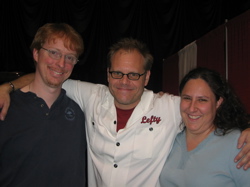This one is going out to all the social conservatives in the room.
Congratulations, people! You’ve managed to strike a blow for the promulgation of promiscuity and the diminishment of the American dream. That was the point, wasn’t it?
Yes, I’m referring to the eleven state issues that passed a week ago, each and every one declaring marriage to be the union of a man and a woman, period, move to France if you don’t like it, end of story. Here in Ohio, we passed one of the most stringent versions by amending our state constitution to define marriage that way, and also to prohibit the granting of equivalent legal status to any other kind of union. Which means that not only can gays not get married in Ohio, but their domestic partners can’t be granted any of the rights and priveleges that marriage confers even by means of a civil union or some other not-marriage-in-name-only device. The same is true for heterosexual domestic partners. You’re either married, or you’re out of luck. And if you’re gay, well, it would seem you’re just plain out of luck.
So yes, that’s right, oh noble defenders of morality, by enshrining your discomfort with homosexuality, you’ve done your level best to promote continued homosexual promiscuity. After all, American society is pretty clearly telling gays that they shouldn’t ever hope to have a long-term committed relationship recognized by the state. So is it any wonder that they don’t tend to form such relationships? There are, of course, exceptions; I know of at least one gay couple that’s been together for a decade and a half now. But they aren’t legally married, nor can they be so long as they live in this state, or really almost anywhere in this country. The message is loud and clear.
As for the American dream, well, your crusade has tarnished that as well. Remember “life, liberty, and the pursuit of happiness”? So much for the last of the three. When two people love each other enough to commit their lives to each other, why should anyone else stand in the way of their happiness? And yet we do, as a society. In the name of our discomfort, we impair their happiness. Life and liberty are still mostly assured, although it’s likely Matthew Shepard would choose to disagree, if only he could.
I know that I’m generalizing here, but at the same time, this is what our democratic process has delivered. If a vote is the voice of the people, they’re saying something that tastes like ashes to me. It’s the same process that blocked interracial marriages for so many years. It’s about as right now as it was then.
You know, according to the CIA World Factbook, the population of the United States in 2003 was 290,809,777. According to the ratios documented in multiple studies, approximately 29,080,977 of those Americans are homosexual. The total membership of the largest Baptist churches in the United States, by comparison, was about 29,553,000—roughly the same size as the homosexual population. (And of couse there are people who are members of both sets.) Since we’re all apparently willing to prohibit small minorities from marrying, I say we define marriage to be a union between a man and a woman, neither of whom is Baptist. Sound fair?
Yeah, I thought you’d feel that way.
(Ed. note — it has been pointed out that the 10% figure is no longer accepted. Unfortunately, there is not much in the way of firm data on the actual percentage of homosexuals in the American population. One source describes research which gives a variety of numbers that can, depending on one’s definition of “gay”, yield figures anywhere from 4.2% to 13.4% of the population. The abstract point being made still stands regardless of the exact numbers, but the original inaccuracy is regretted.)
I’ve had some friends ask me when I’ll be moving, and I can no longer answer “I don’t plan to”, because I’m just not sure any more. The problem isn’t Cleveland, of course. Sure, we have problems hereabouts, but this is a relatively tolerant corner of the state. The particular suburb in which I reside, Cleveland Heights, had the first voter-approved domestic partner registry in America. Our street had about two dozen Kerry signs and one Bush sign, but so far as I know nobody gave the Bush folks a hard time. Heck, the guy who mowed “BUSH” into his lawn the next street over was talked about with neighborly amusement and a touch of admiration toward his level of dedication. Nobody proposed running him out of town. We didn’t even call him names, or speak with derision. We generally live and let live around here. That’s kind of a liberal trait, actually—at least, among the liberals I know. And I know a lot of them.
The problem isn’t even Ohio. Yes, this state collectively told gays (and unmarried heterosexual couples) that we don’t much like their kind. So did ten other states. Right now, the same would happen just about anywhere in America. So the problem seems to be America, or maybe just Americans. Either way, there’s something about homosexuals getting married that a whole lot us just can’t stomach. I don’t know what it is about this issue that has everyone’s panties in a bunch, and to be frank I’m not sure I much care. When I’m this far out of touch with so many of my fellow countrymen, maybe it’s time to consider leaving. After all, if the majority is always sane, then I’m the one who’s wrong here.
It isn’t that easy, of course. I have no real wish to leave behind the country of my birth; I have great affection for America, and deeply believe in the principles on which it was founded, in a time when so many people seem to feel otherwise. It grieves me to think of my country as being on the wrong track, but I do. And then there’s my family to think about, but that actually deepens the quandry. I don’t exactly want to ask them to move over a point of principle, but at the same time, I’m not at all sure I want to raise my children in a country that seems to have become so shamefully intolerant and narrow-minded. Kat and I will set for them the best example we can, but when it’s us against the body politic, well, we’re just a little outnumbered. We might be better served to find a society that will support our beliefs, instead of one that opposes and belittles them.
This isn’t an attack on America, and it isn’t a promise to leave, and it isn’t a story with any kind of decent ending. It’s a glimpse into one citizen’s inner disappointment. It’s an attempt to exorcise some of my frustration, and to plead a case, however clumsily. It’s a lament for a noble dream, one we seem to have forgotten in the heat and noise of our harried, fearful lives.
I wish I could end with a flourish, or even better, with an answer, a call to action. All I have is a sorrowful shake of my head and a small shrug of resignation.
 We stood in line to get our copies of his books signed, and also to thank him for his Thanksgiving turkey recipe, which quite literally changed how we cook. I also told him his Web site (specifically, the wonderful Rants & Raves) needs an RSS feed. He told me he had no idea what the hell that means. That’s all right. Until Alton explained it on his show, I couldn’t have told you what a Maillard reaction was, let alone how it related to cooking.
We stood in line to get our copies of his books signed, and also to thank him for his Thanksgiving turkey recipe, which quite literally changed how we cook. I also told him his Web site (specifically, the wonderful Rants & Raves) needs an RSS feed. He told me he had no idea what the hell that means. That’s all right. Until Alton explained it on his show, I couldn’t have told you what a Maillard reaction was, let alone how it related to cooking.
 This past Tuesday, and by that I mean three days ago, Carolyn stood unsupported for the first time, wobbling in place for five seconds. She stood on her own a few more times Wednesday and Thursday, gaining a little more experience and confidence each time.
This past Tuesday, and by that I mean three days ago, Carolyn stood unsupported for the first time, wobbling in place for five seconds. She stood on her own a few more times Wednesday and Thursday, gaining a little more experience and confidence each time.